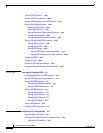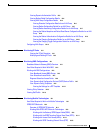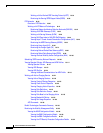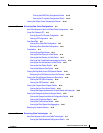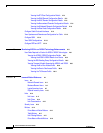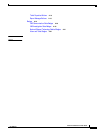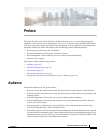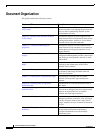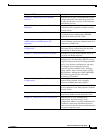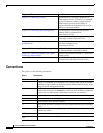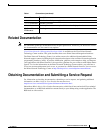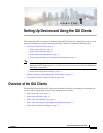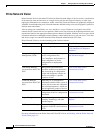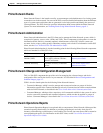
xxiv
Cisco Prime Network 4.0 User Guide
OL-29343-01
Document Organization
This guide contains the following sections:
Chapter and Title Description
Chapter 1, “Setting Up Devices and Using the
GUI Clients”
Describes the suite of GUI tools that offer an
intuitive interface for managing the network and
services, and for performing required system
administration activities.
Chapter 2, “Working with the Prime Network
Vision Client”
Describes the user access roles required to use
Prime Network Vision, the Prime Network Vision
working environment, and how to access Prime
Network Vision tools and commands.
Chapter 3, “Viewing and Managing NE
Properties”
Describes the user access roles required to use
Prime Network Vision and how to view network
element physical and logical properties in any
mapped network.
Chapter 4, “Device Configurations and Software
Images”
Describes the features that Change and
Configuration Management provides, some initial
setup tasks you must perform, and how to work
with the GUI.
Chapter 5, “Working with Prime Network Vision
Maps”
Describes how to work with the topological maps
displayed in the content pane of the Prime
Network Vision window.
Chapter 6, “Working with Links” Describes how to view information about static
and dynamic links using the Prime Network
Vision user interface.
Chapter 7, “Labeling NEs Using Business Tags” Describes how to manage and view Prime
Network Vision business tags and business
elements.
Chapter 8, “Tracking Faults Using Prime
Network Events”
Describes how to use Prime Network Events to
track faults.
Chapter 9, “Working with Tickets in Prime
Network Vision”
Describes viewing tickets in Prime Network
Vision, how to manage tickets that represent fault
scenarios of selected devices or network
elements, and fault impact analysis.
Chapter 10, “Working with Reports” Describes how to use Prime Network Report
Manager to generate, customize, view, and export
a variety of reports about events, traps, tickets,
syslogs, software versions, elements, and network
services.
Chapter 11, “Using Cisco PathTracer to Diagnose
Problems”
Describes how to perform end-to-end route
tracing and the performance information
displayed simultaneously for the multiple
networking layers.



